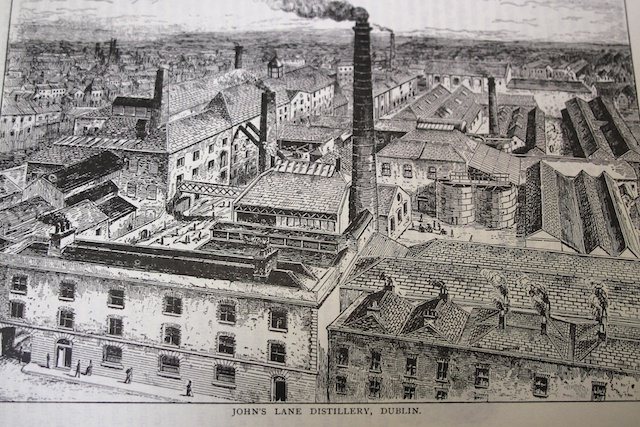The John's Lane Distillery

It's common today to see a producer in a particular region rename one of their whiskies after an old, regional distillery no longer in existence. Springbank, for example, makes two single malts called Longrow and Hazelburn, named after the former Campbeltown distilleries. Bruichladdich has Port Charlotte, named after what was once an old neighbor. However, I didn't realize until today that the new Powers Irish whiskey, the 12 Year Old John Lane, was named after an old Irish producer in Dublin, which was the original home of Powers beginning back in the late 1700s.
James Power, an innkeeper from Dublin, established the John's Lane distillery in 1791. Our old pal Alfred Barnard once visited John's Lane (and provided some wonderful sketches) and had this to say:
In the year 1791 this hostelry was converted into a small distillery, making about 6,000 gallons annually, its chief motive power being a horse mill. But it did not remain long at that small output. The founder was a man of energy and enterprise, and year by year, as his business increased, he continued to extend the distillery. Since 1871 the whole place has been rebuilt in a handsome and modern style, and every known appliance in the art of distilling added thereto. The establishment now covers a six-and-a-quarter acres of ground, and the offices, which abut on the busy thoroughfare of Thomas Street, form and substantial frontage to it.
Passing through the lofty and spacious public offices, we crossed a paved court and entered the noble block of buildings devoted to the storage of grain. They are five stories high, well lighted, and measure 192 feet long by 100 feet broad. The barley is carted to the distillery by the farmers, and lifted by hydraulic hoists to the receiving rooms. At the entrance to this department there is an enclosed office, with glass roof and sides, in which sits the corn-sampling clerk; a portion of each delivery is handed to him for comparison with the samples of the purchase, which hang in bags upon a frame on the wall. If the sample is not up to the mark he refuses delivery, and reports the fact through the telephone to the corn-buyers office.
The first process of the manufacture of whisky now begins, by the corn being sent from these two floors to the to kilns adjoining, whither we next bent our steps. These kilns are indeed elegant buildings, each measuring 57 feet by 30 feet, with open groined roofs, lined with wood and stained oak, like small English parish churches, in fact far superior to many we've seen. Iron doors shut off these kilns, which are heated by open furnaces, and floored with the patent perforated Worcester tiles.
What's interesting about this description is that Barnard is describing the grain component of Irish whiskey, in this case the "corn." Barnard goes on to describe the malt side of the distillation as well, since Irish whiskies are almost always blends.

A noble-looking building is the still house. It is 68 feet long, 66 feet wide, and 57 feet high, containing five pot stills, all kept as bright and clean as burnished gold; the wash flows by gravitation to two wash stills, each holding 25,000 gallons, and said to be the largest pot stills ever made.
The detail with which Barnard goes on concerning the process at John's Lane distillery is about five times as long as he spends with most other producers, leading one to believe he was quite impressed with the distillery.
Does he describe the whisky? Yes, indeed.
On completing our tour of inspection over the distillery, we accepted the hospitality of the partners and did ample justice to a substantial luncheon. We had previously sampled the firm's make of 1885, which we thought good and most useful, either as a blending or single whisky. The old make, which we drank with our luncheon, was delicious, and finer than anything we had hitherto tasted. It was perfect in flavour, and as pronounced in the ancient aroma of Irish whisky so dear to the hearts fo connoisseurs, as once could possibly desire, and we found a small flask of it very useful afterwards on our travels.
Since John's Lane distillery made pot still Irish whiskey, the new Power's 12 Year Old John Lane edition is also 100% pot still whiskey, unlike the standard Powers 12 Year old. It's made today at Midleton distillery, the home of Jameson, Paddy, Midleton, and Redbreast. It's unlike any other Irish out on the market currently with its leathery, tobacco notes on the finish. Quite potent stuff. It seems that Irish whiskey was once quite a populated market. Alas, there are only a handful of Irish whisky distilleries around today. Check out this list from Barnard's time, however:
Dublin
Bow Street - John Jameson & Son
John's Lane - Sir John Power & Son
Thomas Street - George Row & Co.
Marrowbone Lane - Wm. Jameson & Co.
Jones Road - The Dublin Whisky Distillery Company, Limited
Phoenix Park - The Distillers Company, Limited
That's just in Dublin! Nearly twice as many than exist today. Then there's another 22 scattered all over the rest of the country that I need to read through and research.
What a time that must have been for Irish whiskey! In any case, I'll have to sip my bottle of the Powers John Lane edition in the meantime and think about what it must have been like.
-David Driscoll
